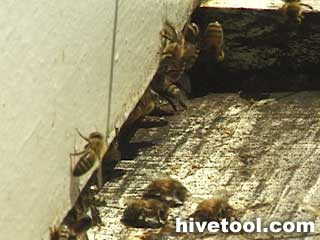



Honey Bee Stings
Honey bee stings are not a major medical problem for 99 percent of our population.
The barbed stinger of the bee is embedded in the beekeeper's skin. The venom continues to be injected into the skin as the barbed stinger is forced deeper into the flesh. Remove the stinger with a knife blade or fingernail with a scraping motion along the skin surface. Immediate removal of the stinger will minimize the effect of the sting.
Most persons do not experience anything other than localized swelling, redness and pain as the result of being stung. This will persist for up to three days. Immediately remove the stinger and apply honey from the comb to the affected area. This should give immediate relief from the pain following a sting. Fortunately, most persons develop a tolerance to the stings, and their reaction to stings is much reduced after frequent, repeated stings. Some persons are hypersensitive to the bee venom and develop an anaphylactic reaction within minutes after being stung. A person suffering an allergic reaction must receive medical attention immediately. Commercial kits are available by prescription. The kit consists of a preloaded syringe of epinephrine hydrochloride and antihistamine tablets. Persons that have shown evidence of increasing severity of reactions to bee stings should have the necessary medications available at all times. The commercial kits will aid in preventing or controlling life threatening situations following a bee sting.
Treatments to desensitize highly sensitive persons can be conducted by physicians. These treatments can greatly reduce the reaction to stings by sensitive persons.